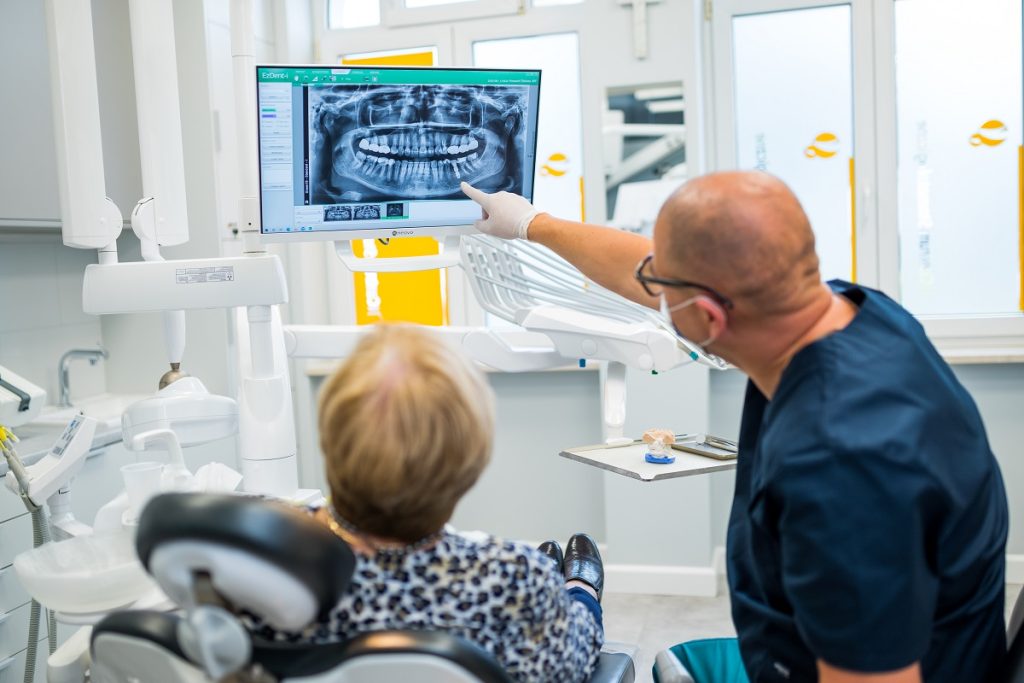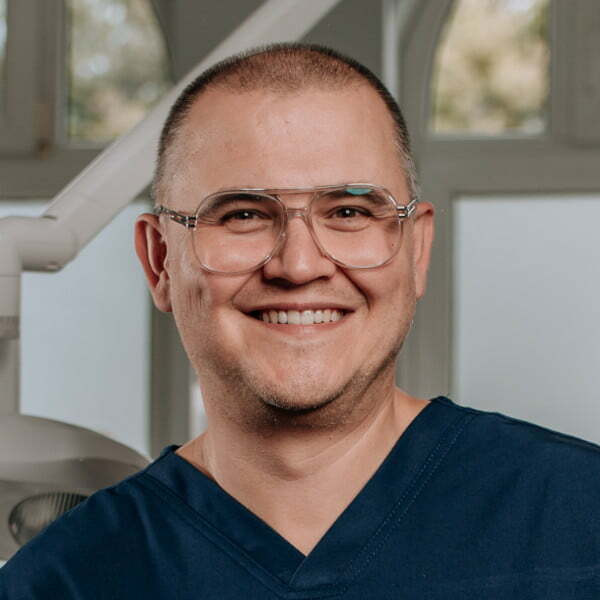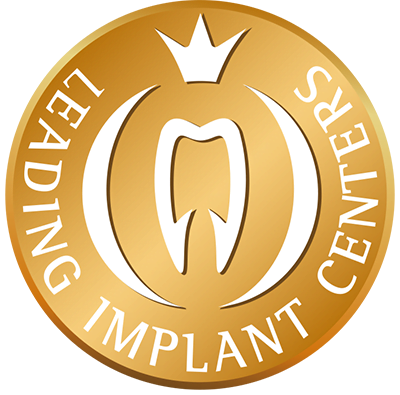Dental implants are currently the most advanced and excellent technology in the field of dental reconstruction. They restore patients’ beautiful smiles and full functionality of the oral cavity.
At the beginning of the implant treatment process, the dentist performs a thorough assessment of the patient’s oral cavity. Based on this assessment and the individual characteristics of the patient, a personalized treatment plan is developed. Depending on the size and location of the cavities, the specialist selects the appropriate implant treatment method to ensure optimal results.

Implantology is a dental specialty (a component of dental surgery) that deals with the use of dental implants as substitutes for natural tooth roots. It aims to replenish dental cavities, rebuild bones and soft tissues to restore patients’ full functionality of the oral cavity and an aesthetic smile.
Dental implants are made of biocompatible materials, such as titanium, which are safe for the body and effectively integrate into tissues. In the implantation process, the specialist surgically places the implants in the jaw bone or mandible. There, a process referred to as osteointegration gradually occurs. It consists of the fusion of the implant with the surrounding bone, which ensures the stability and durability of the implant.
Implantology can be applied in various cases. The most common reason for dental implant application is tooth loss due to trauma, caries, periodontal disease, or aging. However, implants can also be used for cosmetic purposes to improve the appearance of teeth and restore a patient’s confidence. Regardless of the cause of tooth loss, implants are an effective and durable solution that provides a natural look, function, and comfort.
A dental implant is a titanium screw surgically screwed into the jawbone or mandible. Its main purpose is to replace the natural tooth root that has been lost for various reasons, such as trauma, caries, or periodontal disease. The dental implant serves as a stable base for the reconstruction of the missing tooth.
The dental implant is only part of the entire prosthetic reconstruction process. The next stage after the implant’s healing is attaching the dental crown to the implant. The crown can be made of porcelain or other material, which is selected according to the individual patient’s preferences and the specialist’s recommendations. The implant can also serve as a base for dental bridges or implant-supported dentures, depending on the number and arrangement of missing teeth.
Dental implants can have different shapes of screws placed in the bone, different diameters, and different heights. The differences between the individual types are quite arbitrary and from the patient’s point of view, the individual types will not significantly differ from one another.
Therefore, it is necessary to visit a specialist who will create an individual treatment plan, select the appropriate type of implants, and determine how they can be implanted. At this stage, it is important to predict what further orthodontic treatment or prosthetics will look like, because the choice of the implant also depends on it.
This is the basic variant of dental implant insertion. For tooth implant insertion, the bone once surrounding the root should be healthy and strong to provide proper support. This is problematic because the bone structure can weaken or partially atrophy by up to 50% within a year of tooth root removal. The implantation procedure itself allows to stop the processes of bone atrophy.
The implantation procedure itself has a positive effect on the maintenance of bone structure. During the implantation process, the titanium screw of the implant is precisely screwed into the bone of the jawbone or mandible. During the procedure, there is direct contact between the implant and the bone, which stimulates the reconstruction process and maintains the integrity of the bone tissue.
Lifting of the maxillary sinus, also known as sinus lift, is a surgical procedure used in cases where bone structures in the lateral part of the jaw are incomplete or too low, which makes the placement of the dental implant difficult. This procedure is intended to increase the amount of bone available in the maxillary sinus area, which enables subsequent implantation of the dental implant.
During the procedure of sinus lift, the dental surgeon introduces bone substitute material or autologous bone graft into the sinus, under the Schneiderian membrane. This material is intended to increase the volume and height of the bones in the sinus area. After the introduction of bone graft, the space is closed and the wound is stitched.
The healing time and integration of the bone graft into the natural bone is typically within 6 to 9 months after the sinus lift. During this time, the lifted sinus stabilizes and ossification occurs, forming a solid basis for the placement of the dental implant. The final decision regarding the time of implantation after the sinus lift depends on the individual patient’s situation and must be made by the implantologist.
In the event of extensive bone loss in the place of the planned implantation, an experienced dental surgeon may propose the use of a bone block graft. Such a procedure requires harvesting one bock from the unaffected site and transferring it to the place of the planned implantation. Thanks to the use of anesthesia, the patient does not feel pain during the procedure, however, the recovery period, which lasts several months, may cause some discomfort.
A few months will pass before a dental implant specialist invites you for a final consultation and finally the implant placement. We make every effort to ensure conducting a safe procedure in our office. However, the patient will have to familiarize themselves with a certain list of contraindications. They may result from family health history, past or present medical problems, as well as abnormal test results.
It is a bone graft procedure with immediate implantation, used in the case of smaller defects. A fragment of bone in the shape of a torus (ring) is harvested. The hole in such a prepared ring will be used for the implant placement, which takes place during the same visit. Since it is a single procedure, the risk of complications is limited, and because the operating area is also smaller, the patient’s comfort is greater.
Importantly, this implantation method is available if the patient’s blood tests and medical history do not indicate the ongoing disease process, the patient’s oral cavity is in good oral health, and the implantologist decides that in this specific situation, they will be able to harvest a bone fragment strong enough to serve as a fixation for the tooth implant.
Implant hygienization is a key element of taking care of the health and long-term functioning of dental implants. Regular cleaning and hygiene around implants and proper dental care are essential for infection and inflammation prevention as well as maintaining the long-term effect of implant treatment.
As part of implant hygienization, a specially trained implant hygienist cleans and cares for implants and soft tissues in the area. They work using modern equipment and tools specifically designed for cleaning implants, such as ultrasonic scalers and specialized toothbrushes.
During the visit, the implant hygienist thoroughly cleans the implants, removes plaque and bacteria from the surface of the implants, and removes tartar from adjacent teeth. This is important because the presence of bacterial plaque and tartar around implants can lead to inflammation of the gums and mucosa and even loss of the implant.
The list of contraindications for performing implant procedures is quite short, but it is worth remembering that the doctor may use the extensions in relation to some (mainly more invasive) methods.
Absolute contraindications are:
Of course, there are also local contraindications, i.e. related to poor oral health (caries, plaque and tartar, gum disease).
Filling dental cavities with implants does not require special preparation. You should consult a doctor beforehand, get the recommended medical examinations (their list may vary depending on whether and what additional implant procedures are necessary), and ensure proper oral hygiene. Sometimes additional specialist consultation will be necessary, but this should rather be considered as early preparation, while there are no additional obligations on the patient’s part immediately before the procedure.
Before the start of the procedure, the implantologist will assess the condition of the oral cavity and inform the patient if it is necessary to postpone the procedure.
Postoperative management is an important element of implant aftercare. After the dental implantation procedure, there are several steps that the patient should take to ensure proper healing and durability of the implants.
You can find some aspects of the post-treatment procedure below:
Postoperative management is critical to the success of implant surgery.
Dental implant procedures are usually performed with the use of local anesthesia, which minimizes pain during the procedure itself. The implantologist tries to provide the greatest comfort to the patient and monitors appropriate anesthesia to avoid discomfort.
However, some patients may experience slight discomfort or slight pressure sensation during the procedure, associated with manipulation around the soft tissues and bones. In such cases, it is important that the patient is open and communicates their sensations with the implantologist. The doctor can then adjust the anesthesia or take additional measures to provide more comfort to the patient.
After the procedure, during the healing period, certain symptoms may occur, such as swelling, slight pain, or a feeling of tension in the implant area. These are the body’s natural reactions to the healing process. In most cases, these symptoms are mild and can be controlled with basic painkillers as directed by your doctor.
For more complex implant procedures such as sinus lift or bone grafting, more advanced anesthesia or additional analgesics may be necessary. The implantologist will address these issues with the patient before the procedure and undertake the appropriate measures to minimize pain and discomfort.
The cost of a dental implant depends on the extent of the procedure, the chosen technology, and the necessary additional procedures. The basic costs are presented in the table below
The procedure of placing a dental implant in HCentrum is the best way to fill in the missing teeth and regain a beautiful smile. We will select the optimal dental implants, prepare a detailed treatment plan and carry out the entire procedure to the highest standards.
By choosing implants in Gdansk and HCentrum, you can regain self-confidence and comfort in everyday functioning.


HCentrum Stomatologiczne Jasińscy is a member of the prestigious organization, Leading Implants Centers, which brings together the best implant offices in Europe.
